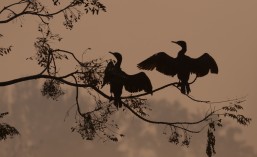Order: Passeriformes Family: Estrildidae Conservation Status: Least Concern
Synonyms: Black-headed Munia, Red Maya, Black-headed Mannikin, Black-headed Nun, Chestnut Mannikin, Black Hooded Nun, Southern Black-headed Munia, Chestnut Nun, Black-headed Nun
Description:
The Chestnut Munia is a small stocky bird, measuring 11 to 12 cm in length. Adult birds have a stubby pale blue-grey conical bill, all black head and chestnut-brown body. The belly and undertail coverts are blackish, whilst the upper tail coverts are orange-yellow with yellowish edges. There is a small brick-red patch on the lower back which is only visible when the bird is in flight.
There is no sexual dimorphism in adult birds.
Juvenile birds lack the dark head of the adult and have uniform pale brown upperparts with white to pale buff underparts making them indistinguishable from juvenile Scaly-breasted Munias (Lonchura punctulata) and juvenile White-headed Munias (Lonchura maja).
Call and Vocalisation:
Only the male Chestnut Munia sings and the song, which begins with a series of almost inaudible clicks, is described as the sound of “a kitten mewing from a distance”.
The call is described as a shrill “preep”.
Chestnut Munia call
Chestnut Munia call
Range and Distribution:
Chestnut Munias are found in South Asia (Northern India, Nepal and Bangladesh), Southern China and Taiwan, through Southeast Asia (Cambodia, Laos, Myanmar, Thailand and Vietnam) and along Peninsular Malaysia to Singapore, Indonesia and the Philippines.
Established populations have been introduced into Japan, Hawaii, Vanuatu, Jamaica, Martinique and southwest Ecuador.
There are seven recognised subspecies:
ssp. atricapilla – Found in Northeast India, Bangladesh, Myanmar and Southwest China
ssp. batakana – Found in North West Sumatra. This subspecies has a maroon-brown rump and tail.
ssp. deignani – Found in Thailand, Southeast China and Indochina. Compared to the nominate race the body is a darker mahogany-red with a dusky to dark brown belly and under tail. The upper tail coverts and tail edges are orange whilst the rump is brown.
ssp. formosana – Found in Taiwan and northern Luzon in the Philippines. This subspecies has a dark brown head with a grey nape.
ssp. jagori – Found in the Philippines (except northern Luzon), Borneo, Sulawesi and the surrounding islands. This subspecies has a dark brown nape and maroon rump.
ssp. rubronigra – Found in India and Nepal. Compared to the nominate race this subspecies has maroon-brown upper tail coverts.
ssp. sinensis – Found in the Malay Peninsula and northern Sumatra. This subspecies has a brown to dark brown belly and under tail coverts.
Habitat:
The Chestnut Munia is found in open grassland and cultivated grassy areas, especially swampy grasslands, marshy areas, reed beds, rice fields and forest / mangrove edges.
Diet:
The Chestnut Munia feeds mainly on grain and other seeds.
Breeding:
The breeding season for the Chestnut Munia varies across its range, running from May to November in India, June to September in Myanmar and December to October in Malaysia.
The nest of the Chestnut Munia is a large domed structure, constructed from dry grass and fine twigs. It is usually built close to the ground in a densely packed bushes or tall grasses. A clutch of 4 to 7 white eggs are usually laid. The eggs are incubated for 12 to 15 days and hatchlings fledge after a further 22 to 28 days. Both sexes are involved in nest building, incubating and rearing the hatchlings.

